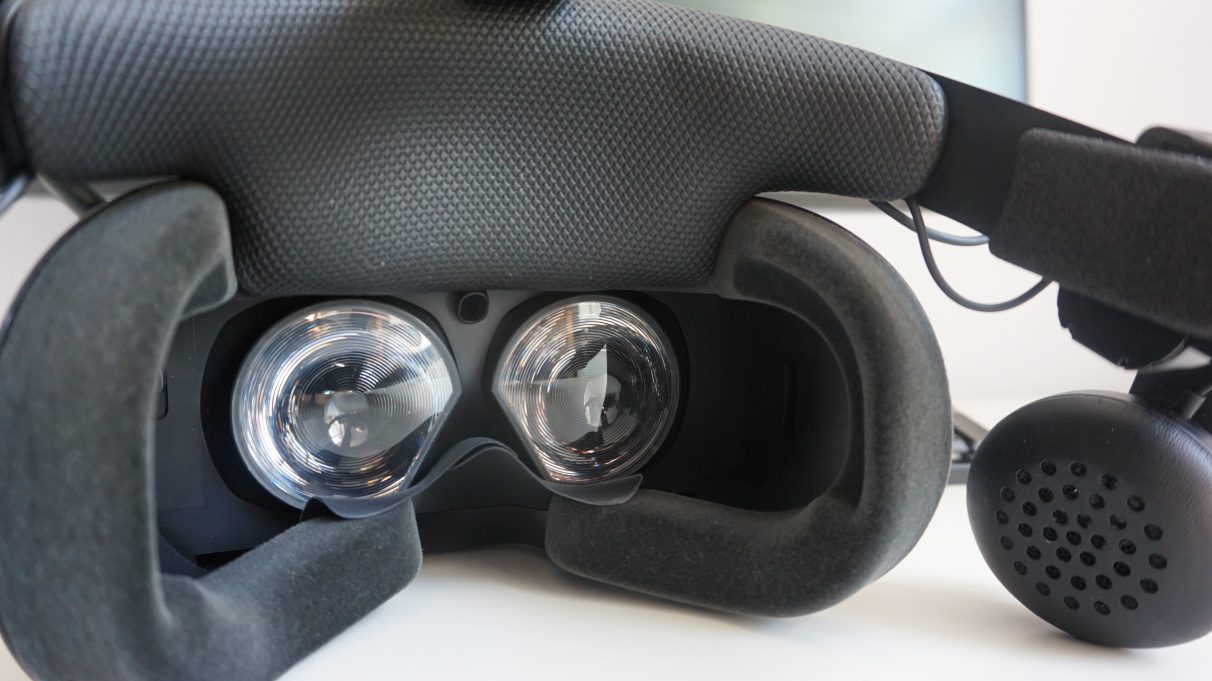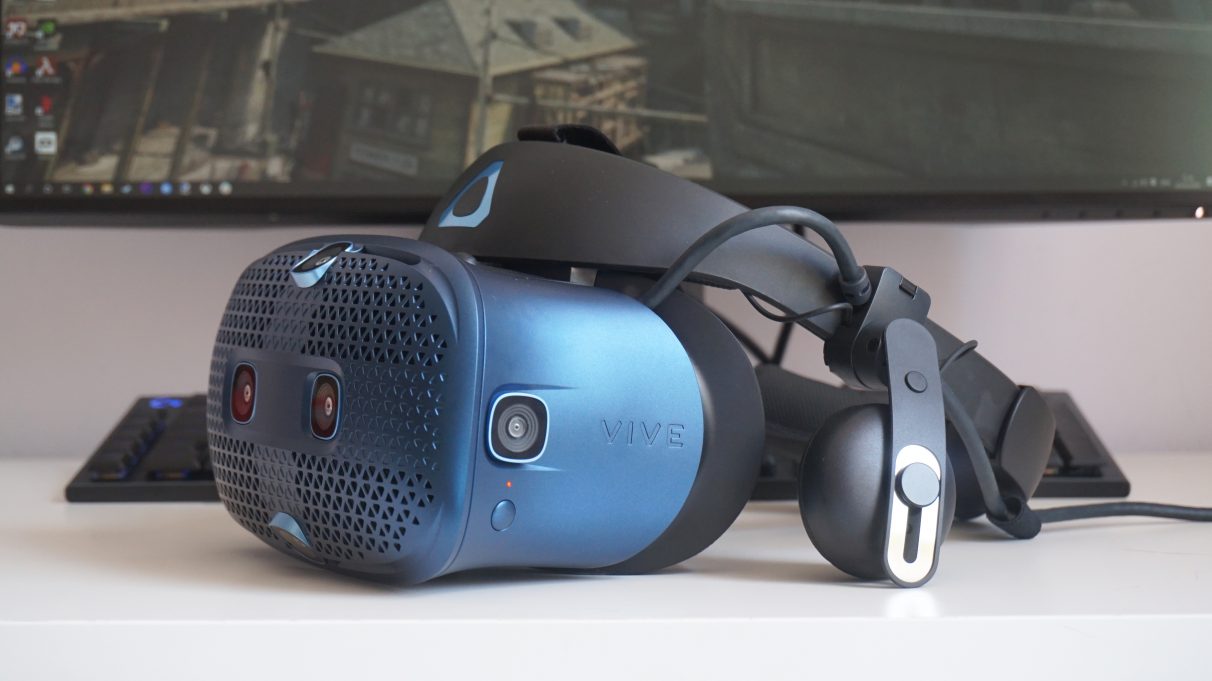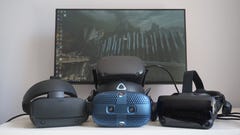HTC Vive Cosmos review: the modular VR headset with all the right ideas
But it struggles to stick the landing
VR headsets have always been quite an expensive proposition for a lot of people. Oculus may have been slowly driving down the price of VR over the last couple of years with their PC-based Rift S headset and standalone Oculus Quest, but HTC's Vive headsets have remained firmly at the higher, more prohibitive end of the VR gaming pool ever since the very first Vive came out in 2016. At first, it was all to do with delivering a superior experience to Oculus' respective headsets thanks to HTC's superior tracking technology, room-scale VR and higher resolution display, but the onward march of technology has meant that upgrading a Vive headset has become increasingly more costly with every new iteration.
The HTC Vive Cosmos attempts to rectify that problem with its modular faceplate design. Instead of having to chuck out the entire headset when a new one comes along, all you need to do with the Vive Cosmos is buy a new tracking faceplate and snap it onto the front. It's a brilliant idea in theory, and one that's just beginning to come to fruition with the upcoming release of the even cheaper Vive Cosmos Play and the more advanced Vive Cosmos Elite headsets. You can read my HTC Vive Cosmos Elite here, but needless to say, buying a new faceplate for £200 / $200 is a lot easier on the wallet than shelling out almost a grand for an entirely new headset. Is it an ecosystem worth buying into, though?
Compared to the original Vive and Vive Pro, the Vive Cosmos is a big improvement, both in terms of design and its overall specs. Not only does it have a sharper, higher resolution display of 1440x1700 per-eye, creating a combined resolution of 2880x1700, but the headset's overall ergonomics have also been refined to make it feel like a more modern, premium bit of kit that's more deserving of its £699 / $699 price.

The rear dial, for example, makes it much easier to stretch over your head than its two predecessors, and its front hinge allows you to flip up the display if you need to chat to someone or check something on your PC without having to take the entire thing off your head. The velcro strap that goes over the top of your head still feels a bit budget, admittedly, but when most of the weight is centred around the front of the headset, it does help to take some of the pressure off your cheeks and forehead. Besides, even the more expensive Valve Index still has a velcro strap, so it's probably just something we'll have to put up with until someone comes up with something a bit more elegant.
The Vive Cosmos also has built-in headphones, negating the need to plug into a separate headset and have yet another contraption weighing you down like the original Vive. Best of all, though, it has inside-out tracking, which means you don't have to scramble around finding multiple plug sockets for any external trackers. Instead, everything you need is built right into the headset and its accompanying controllers. This was one of my biggest gripes with the original Vive, as there wasn't a single room in my house where I could really set it up without trailing long cables across the floor.

The Vive Cosmos, on the other hand, is a lot simpler to get going. All you need to do is plop the bundled batteries in the controllers, attach the headset to the control box, connect its USB3 and DisplayPort cables to your PC and plug it in. In this respect, the Vive Cosmos is just as convenient and easy to set up as the Oculus Rift S, and on paper it's a headset that I can very much get behind. No external trackers, good specs, a smaller dent on my wallet when it comes to upgrade... Delightful.
In theory, at least. In practice, getting the Vive Cosmos to play nicely with my PC was an altogether more frustrating experience. Not once in my entire month of testing was I able to just plug the headset in and start playing games. Instead, I had to spend at least half an hour trying to wrestle SteamVR into submission before I could get it working, which was constantly crashing and encountering fatal errors on start-up. It also seemed to be in perpetual conflict with Vive's own Console software, which also wasn't much help in trying to diagnose what the problem was. Instead, I was just had to restart the headset over and over again until some magical moment when both bits of software decided to shake hands and put their differences aside. In fairness, I also had problems getting SteamVR to play ball with the Valve Index, but the extra hurdle of getting SteamVR and Vive's Console software working at the same time definitely threw an extra spanner in the works.
As I mentioned in my article about the best VR headset for Half-Life: Alyx, I also encountered problems getting the Vive Cosmos' inside-out tracking to work properly. On a bright sunny day with the curtains open, the Cosmos said my room was too bright. At night with the curtains closed and the lights on, it said that my room was too dark. The only time when it didn't throw up a warning message was during the day with my curtains closed.

That seemed to be the sweet spot for the Vive's six cameras, but so far I haven't encountered this sunlight issue with any other VR headset I've tested. The Valve Index, Oculus Rift S and even the Oculus Quest have all seemed to cope with open curtains perfectly fine at time of writing, and it just ends up adding another source of frustration to the Vive Cosmos' setup compared to the competition.
You can still carry on using the Vive Cosmos despite these messages, of course, but it does affect the headset's ability to track both your hands and the world around you accurately. Indeed, there were several moments when the whole world juddered and froze for a bit, even when I was doing something fairly sedate such as looking around Vive's home menu, and my virtual hands did all sorts of strange things when I was playing Half-Life: Alyx, too, from straying away from my body to getting stuck on bits of furniture.
Once I'd got the software working and shut my curtains to get the right lighting, though, the experience of playing games on the Vive Cosmos was actually pretty all right. I was able to get a pretty sharp picture, too, once I'd used the little dial nozzle on the lower right of the headset to adjust the interpupillary distance, and I didn't have to keep shifting it about on my head too much to keep everything in focus.The rear dial was strong enough to keep the headset in place, and for the most part I was able to read text perfectly fine.
There's still a slight port-hole effect if you look too closely at the very edges of the screen, however, and in some games there were noticeable halo effects framing my field of vision when I looked at bright text on darker backgrounds. Here, it became a lot harder to keep things in focus, as the sheer amount of light pouring out of these words made everything around them look fuzzy and indistinct. This varied game to game - I didn't notice anything to the same extent in Half-Life: Alyx, for example - but it's still another point of contention all the same.
It's a shame, as there's actually very little light bleed coming in from the bottom of the headset once it's on your face. The Vive Cosmos does a very good job making you feel immersed, in that sense, and there was plenty of room to fit a pair of glasses in there, too. The fit wasn't quite as comfortable as when I was wearing my contact lenses, all told, but this is to be expected. This may be because I have a narrower face than most, but at no point did it feel like they were being crushed against the side of my face while I was wearing them.

If anything, the greatest source of discomfort came from padding around my forehead. Again, this may simply be a result of having a slightly smaller head than your average PC gamer, but I always came away from the Vive Cosmos feeling like I had a really bad tension headache. It didn't press down on my cheeks like the Rift S or Oculus Quest, but the extra pressure on my forehead was arguably just as uncomfortable overall. As a result, I had to take regular breaks while playing the Vive Cosmos, keeping play sessions to around half an hour.
The controllers are also quite heavy compared to other VR headsets. This wasn't a huge problem in the grand scheme of things - they're not so heavy that they started to make my wrists ache or anything - but there were times when they felt noticeably more cumbersome than the competition. My thumbs tended to gravitate toward the face buttons rather than the analogue sticks, for example, which sometimes resulted in a fleeting moment of panic as I fumbled around for them in the dark, and the rear triggers often felt quite spongy and slow compared to the taut clicks and lovely sense of tactile feedback offered by its Oculus and Valve rivals.
In fairness, this kind of controller-based stodginess only really reared its head in fast-paced action games - Half-Life: Alyx included. When I tried more sedate VR games, such as Job Simulator, the Cosmos controllers were perfectly up to the task. Still, given the price of the headset, I would have expected a higher level of responsiveness from both its face and trigger buttons alike.
As for the types of games you can play on the Vive Cosmos, it's compatible with every SteamVR game as well as what's on HTC's own VR store, Viveport. Viveport isn't quite as well stocked with must-have exclusives as, say, the Oculus Store, but there's a decent selection on offer that includes all manner of games, apps and videos. Most of the best VR games, though, are multi-platform.

You also get a free six-month subscription to Viveport Infinity included with the Vive Cosmos, which is HTC's subscription service of so-called 'premium' VR content. This works a bit like Netflix and other streaming subscriptions in that you get unlimited access to all Viveport content and exclusive VR channels for as long as you subscribe, and you can cancel at any time. You also get exclusive discounts and free games to keep in your library forever. Currently, there are two ways to pay for it: monthly at a rather expensive £12.99 / month, or annually, which ordinarily works out at £8.99 / month but is currently £4.49 / month due to HTC's Play At Home sale. I'll need to spend a bit more time sampling the Infinity games before I can definitely say whether it's worth subscribing to or not, but so far nothing has really grabbed me in the same way that some of the games on the Oculus Store have. If you have any recommendations, please do leave them in the comments below.
Ultimately, though, the HTC Vive Cosmos just isn't quite as easy or as enjoyable to use as the rest of its competition. Its inside-out tracking is fine when you've got the right lighting conditions, but it can be quite finicky at times and pales in comparison to the inside-out capabilities of the Oculus Rift S. It felt like I was constantly fighting against it, from the tracking to its Vive Console software, and that's not the kind of reaction I want after spending £699 / $699 on it. I'm also not entirely sold on the headset's modular concept, but I talk more about this in my HTC Vive Cosmos Elite review.
There's no denying that the HTC Vive Cosmos is a great headset on paper, but the execution of those ideas leaves a lot to be desired right now - and sadly I don't think its flaws can be fixed simply by sticking another faceplate on the front of it. There are deeper issues at play here, making for a rather wobbly foundation on which to stake your future VR home.
There is some salvation to be found in the Cosmos Elite, but as we'll soon see, none of that is really down to HTC's hardware. Instead, it's the option to use Valve's Index controllers with it that ultimately save the day, but the sheer cost involved in getting all those relevant components together means that first-time VR headset buyers may as well just save up for the £919 / $999 Valve Index and have done with it. Meanwhile, if it's hassle-free, inside-out tracking you're after, then it's the cheaper £399 / $399 Oculus Rift S you should be buying, not the Vive Cosmos.














